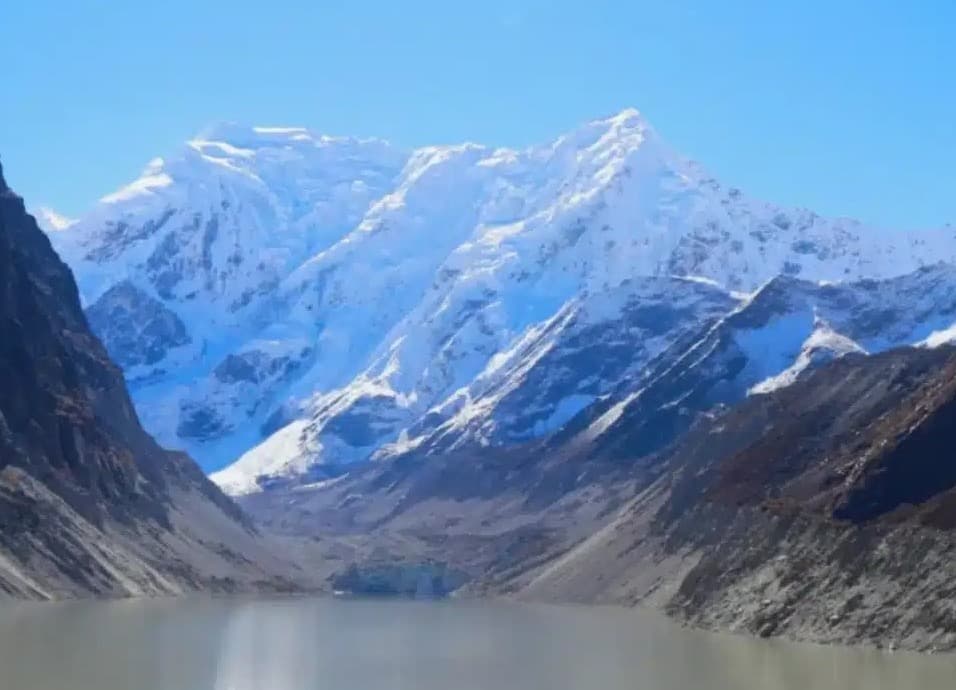Lho is a remote village settlement in the Nubri Valley of the Gorkha district of Nepal, famed for providing stunning views of Mount Manaslu (26,781 ft.), the world’s eighth-highest peak. Lying in between Namrung and Samagaun villages in Manaslu, the townlet also serves as a popular accommodation stop on the Manaslu Circuit Trek route.
Lho village resides at an elevation of 10,433 feet. above sea level. And, although remote, there are many local teahouses and restaurants to cater to tourists traveling to Larkya La Pass (16,752 ft.).
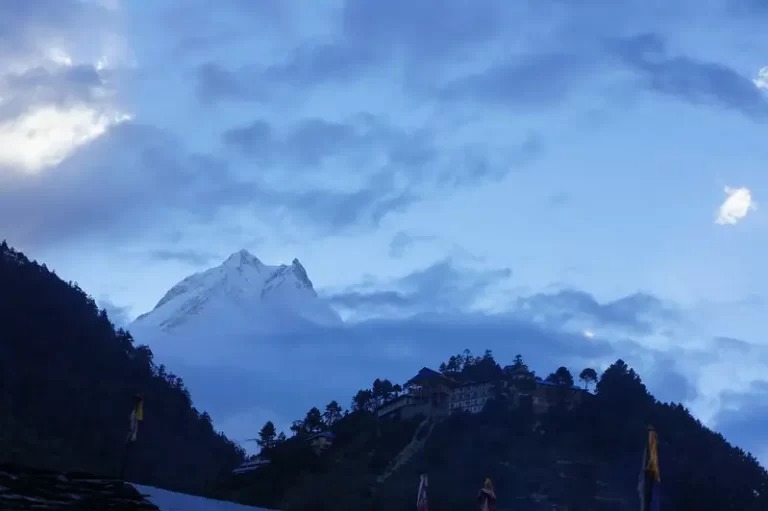
The best time to visit Lho Village in Manaslu
For the most enjoyable experience, plan your visit to Lho Gaun during Nepal’s peak trekking seasons: autumn (March to May) and spring (September to November). These seasons provide delightful weather and unobstructed mountain panoramas.
As previously noted, the temperatures are gentle, making village exploration and hiking a pleasure without the hassle of extreme heat or cold. Additionally, these periods have some of the finest views of Mt. Manalsu from Lho village. Also, this period is the best time to trek to Manaslu.
The major attractions in and around Manaslu’s Lho Village
Ribum Monastery: A Panoramic Retreat
Discover the captivating Ribum Monastery, a short half-hour hike from the village. Enjoy an awe-inspiring vista of the Lho settlement and majestic Mt. Manalsu. The monastery’s serene atmosphere invites meditation and reflection, adding depth to your trekking experience. Moreover, this monastery serves as an educational institution dedicated to the teachings and practice of Buddhism.
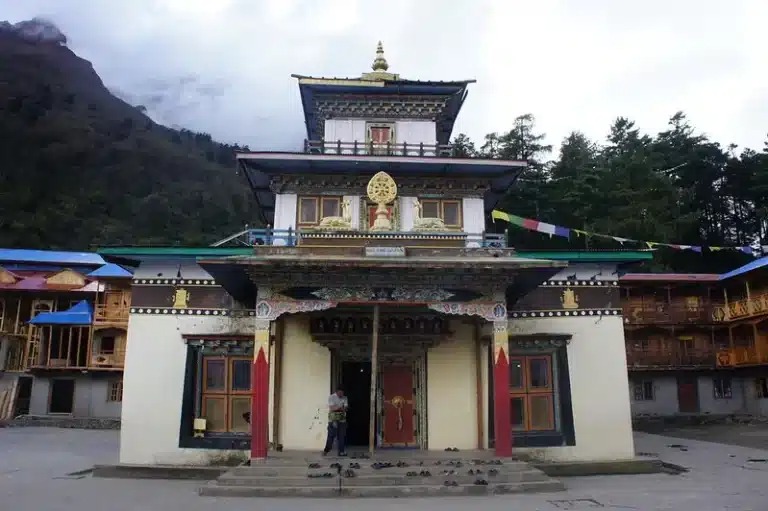
Embrace Local Life: Nubri Ethos
Immerse yourself in the simple yet fulfilling lifestyle of the people of Lho. Engage with locals of Nubri ethnic groups, rooted in agricultural traditions. Witness their humble contentment amid the absence of modern conveniences and appreciate the authenticity of their daily existence.
Spiritual Oasis: Gompas and Monasteries
Explore the Lho village’s intricate tapestry of gompas and monasteries, deeply influenced by Tibetan Buddhism. These sanctuaries serve as centers for ceremonies, meditation, and cultural gatherings. Feel the spiritual energy of these spaces as you connect with centuries-old traditions.
Vibrant Festivals: Nubri Celebrations
Immerse yourself in Lho Village’s dynamic cultural tapestry through its vibrant festivals. Participate in celebrations like Lhosar and Saga Dawa, showcasing colorful ceremonies, traditional rituals, music, and dance. Experience the timeless authenticity of these festivities, passed down from generation to generation.
What services can you expect from accommodations in Lho Village?
Similar to Samagaon, Lho provides commendable accommodation for trekkers traversing the Manaslu circuit trail. The village boasts a selection of teahouses and lodges operated by residents. Opting to stay in these tea houses will grant you immersive cultural encounters.
Despite the variety of accommodation options, most provide basic amenities. Given Lho village’s location in a remote mountainous region, the level of luxury found in Kathmandu city cannot be anticipated.
Likewise, a few tea houses feature rooms equipped with two single beds. Clean bed sheets and blankets are provided to ensure a cozy night’s rest. Limited furnishings are available to arrange your belongings. Most tea houses offer communal spaces for dining and relaxing, where you can enjoy the warmth of a fire and partake in dinner.
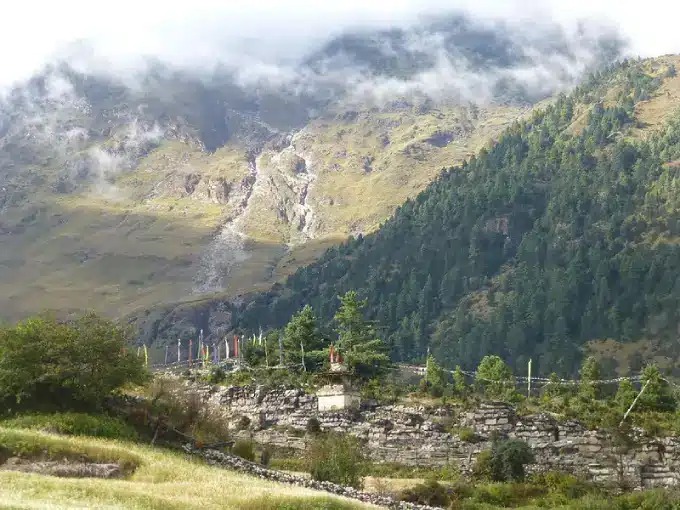
Toilet and Shower Facilities
If you are someone who can’t do without showers, Lho village will be your savior for showers along the Manaslu trail. The majority of tea houses in this area are equipped with facilities for hot showers. It’s worth noting that these showers primarily rely on gas or solar heating methods, resulting in limited availability. Consequently, a nominal fee might be levied for their usage.
While tap water can suffice for washing hands and feet, it’s important to be cautious during colder spells, as the water from the tap tends to freeze. It’s advisable to keep this in mind. Regrettably, laundry services are unavailable in Lho.
Foods and Drinks
Lho village offers a delightful array of local culinary delights, reflecting the skilled cooking of the residents, who adeptly follow traditional Nepalese dishes according to their culture.
One of the village’s renowned culinary treasures is the traditional dish known as Daal Bhat. This wholesome meal consists of daal (lentil soup), seasonal vegetable curries, and pickles of tomatoes or potatoes. This assortment is harmoniously served with steamed rice, creating a satisfying and balanced ensemble.
Another famous food option in Manaslu is the combination of Dhido and Gundruk. Dhido, a mixture of wheat and maize, harmonizes perfectly with Gundruk, a fermented green vegetable leaf.
The Gundruk showcases its versatility as it can be served as a soup, a side dish (Tarkari), or even as pickles. But each variation is a delectable adventure for your taste buds.
For a truly authentic dining experience during your stay in Lho, these distinctive dishes beckon. No exploration of local flavors is complete without a sample of Sukuti, dried meat mainly sourced from Buffalo.
While traversing the colder regions, there is a high importance of beverages. Lho Gaun offers black tea and butter tea, both known for their comforting warmth and invigorating properties.
Likewise, the village provides Raksi, the local term for alcoholic beverages. Crafted from millet (Kodo) or rice, even from mulberries, Raksi serves as a significant element in various social and religious gatherings within the local community.
Drinking Water Options
Learning to stay hydrated is vital for the Manaslu trek preparation. You require around 3 to 4 liters of water daily. In Lho Gaun, you can conveniently refill your reusable water bottle with boiled water from a teahouse, available for a small fee. This option is both secure and cost-effective.
While bottled mineral water is sold in certain shops and teahouses, it’s impractical and expensive to purchase 3 to 4 bottles daily due to the higher costs in the elevated areas of the Manaslu trails.
Phone and Communication
During the trek, you can use two network SIM cards in Nepal: NTC and NCELL. At Lho, the network signals of NCELL are weak, while the NTC network works well. So, you can use your phone for telephone purposes. Furthermore, almost all teahouses have satellite phone services. You can also use Wi-Fi at tea houses for a small charge.
Electricity
Lho village typically has electricity, primarily sourced from solar panels in the teahouses. However, cloudy days could lead to occasional power shortages. Some hotels may conserve energy by turning off power during the day and reactivating it at night.
Charging electronic devices is possible for a fee. During the off-season, when the trail is less crowded, some teahouses might offer charging for free.
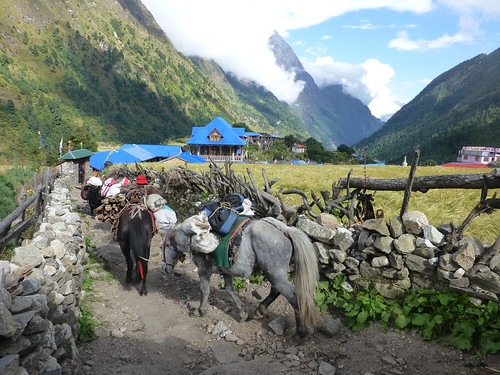
End Note
Located along the Manaslu trails, Lho Village is a true gem. With its enchanting landscapes, rich culture, and welcoming Nubri inhabitants, it offers a distinct experience of the Manaslu trek.
Don’t pass up the chance to behold the stunning Mount Manaslu from Lho settlement—a moment that truly enhances your journey on the Manaslu circuit trek.




